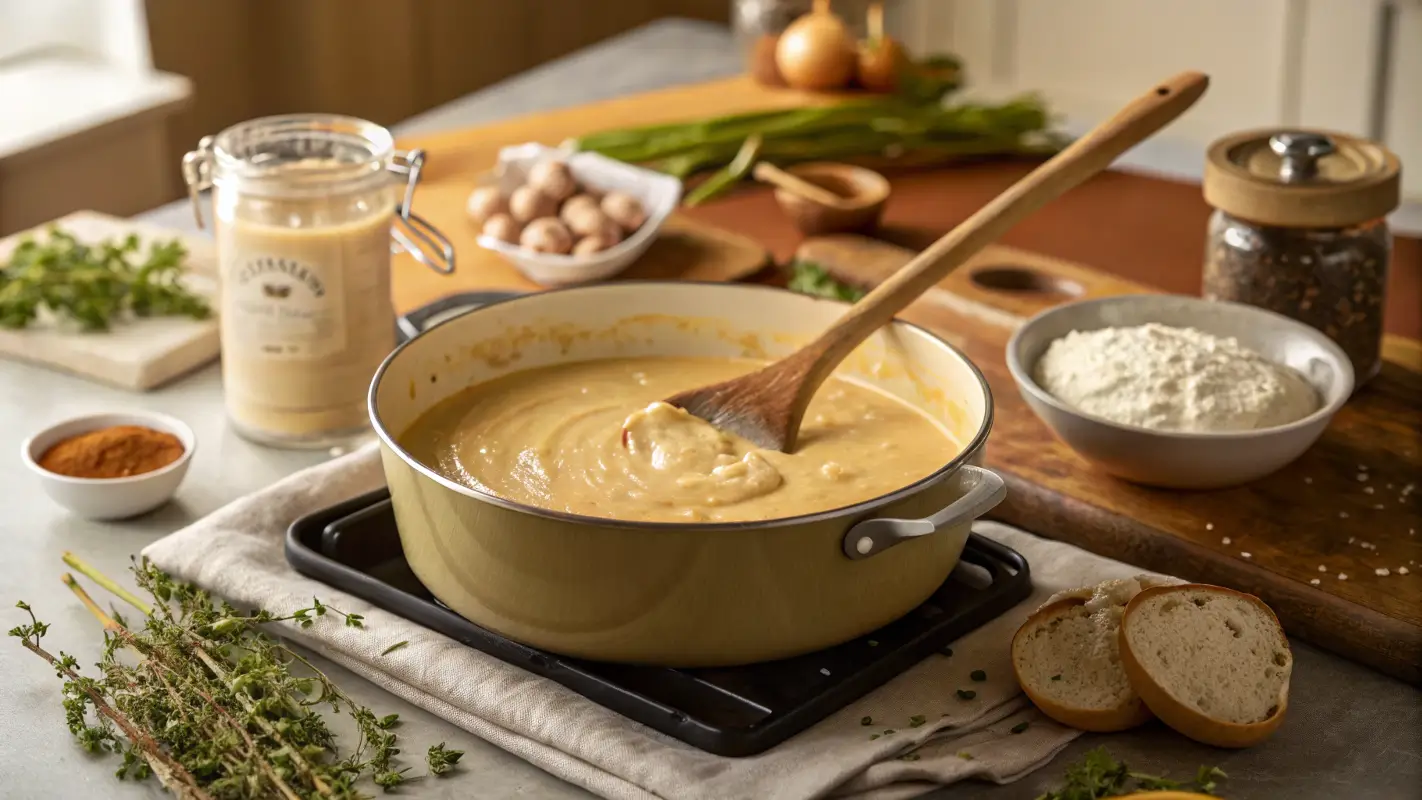Table of Contents
In your quest for the perfect comfort food, good gravy secrets emerge as a true game-changer. This unsung hero elevates every meal from ordinary to extraordinary. However, reaching that rich, smooth perfection might seem daunting. But fear not. We are about to dive deep into the secrets of excellent gravy. Together, we’ll uncover methods, tips, and adjustments to transform your gravy. It will go from a simple sauce to the highlight of your dining experience. Starting with the basics, we’ll then master lump-free thickening. This guide aims to arm you with the knowledge for crafting homemade gravy. It won’t be just any dish but a culinary declaration.
Understanding Gravy
Before we dive into the intricacies of making good gravy, let’s get the basics down pat. Gravy is more than just a sauce; it’s a culinary tradition that brings warmth and richness to meals. Whether it’s enveloping your mashed potatoes in a cozy blanket or adding depth to your roast, gravy is the ultimate comfort food enhancer.
The Role of Gravy in Cuisine
Good gravy secrets have been a staple in cuisines around the globe, evolving over time to include a variety of flavors and ingredients. It’s not just about meat drippings and flour; it’s about capturing the essence of the meal, enhancing and complementing the flavors on your plate.
Types of Gravy
From the velvety richness of a classic meat-based gravy to the light and creamy variants like the beloved homemade gravy for biscuits, there’s a type for every palate and dish. Understanding the different types is the first step in mastering the art of good gravy making.
The Secret Ingredients for Unforgettable Gravy
Now, let’s get to the heart of what makes good gravy truly memorable. The foundation of any great gravy is the quality of its stock and the magic of its thickening agent.
Importance of Stock Quality
The depth and richness of your good gravy begin with its base—the stock. A well-prepared stock, rich in flavors, is essential. Whether you’re using homemade gravy stock or a store-bought version, ensuring its quality and taste compatibility with your dish is crucial.
Thickening Agents: Roux vs. Cornstarch vs. Beurre Manié
Choosing the right thickening agent can make or break your good gravy. Roux, a mixture of fat and flour, is the traditional choice for creating a smooth base. Cornstarch offers a gluten-free alternative, promising a silky finish without the fuss. Beurre Manié, a blend of softened butter and flour, is another excellent choice for last-minute thickening, ensuring your good gravy has that desirable velvety texture.
Focusing on key elements sets you on a path to excellent gravy. It will taste superb and enchant the senses. Indeed, unforgettable gravy’s secret lies in top-notch stock and thickening skills. Soon, we’ll explore more on making perfect gravy. This includes detailed guides, solving common issues, and advanced tips. Stay with us for these insights.
Tips for Perfect Gravy Every Time
Achieving the perfect gravy isn’t just about following recipes; it’s about understanding the nuances that make a gravy go from good to exceptional. Here are some insider tips to ensure your gravy impresses every time.
Achieving the Right Consistency
The key to the perfect gravy consistency is patience. Add your stock slowly to the roux, whisking continuously to prevent lumps. If your gravy seems too thin, let it simmer a bit longer. For too-thick gravy, a splash of stock can loosen it to the desired texture.
Flavor Enhancements
While the basic ingredients of gravy are simple, the addition of herbs, spices, or even a splash of cream can elevate your gravy to new heights. Consider stirring in some thyme or rosemary for a fragrant twist, or a bit of cream for a richer finish.
By mastering these steps and tips, you’re well-equipped to create good gravy that’s not just a side but the highlight of your meal. Remember, the best gravy is made with love, patience, and a bit of culinary flair. Stay tuned for more insights into troubleshooting common gravy mistakes and how to avoid them, ensuring your gravy is perfect every time.
For more gravy insights and tips, check out What Can You Add to Sausage Gravy to Make It Taste Better?, an excellent guide to enhancing your gravy’s flavor profile.
Troubleshooting Your Gravy
Even the most seasoned chefs encounter gravy mishaps from time to time. The good news is, most gravy issues have simple fixes. Here’s how to tackle the most common gravy problems, ensuring your good gravy secrets turn out perfectly every time.
Dealing with Lumps
Lumps in gravy can arise from several missteps, but they’re not a death sentence for your sauce. The easiest way to smooth out lumpy gravy is to use a fine-mesh strainer. Pour your gravy through the strainer, pressing on the solids. For a high-tech solution, a blender can also create a silky-smooth gravy in no time, preserving the essence of good gravy secrets.
Fixing Thin Gravy
If your gravy is looking more like soup than sauce, it’s likely too thin. To thicken it up, create a slurry by mixing a small amount of cornstarch with water, then whisking it into your gravy as it simmers. It’s crucial to bring your gravy to a boil after adding the slurry, as this activates the thickening power of the cornstarch, a key part of good gravy secrets.
Advanced Gravy Techniques
Now that you’ve mastered the basics and know how to troubleshoot common issues, let’s explore some advanced techniques to make your gravy stand out as part of good gravy secrets.
Flavor Layering
Creating a gravy with depth involves more than just adding salt. Consider incorporating umami-rich ingredients such as tomato paste, mushroom powder, or a splash of soy sauce. These can add layers of flavor that make your gravy more than just an accompaniment—it becomes a conversation starter, highlighting the good gravy secrets.
Utilizing Umami
Indeed, umami adds a depth of flavor to gravy, making it irresistibly savory. You can subtly incorporate elements like parmesan rinds, anchovy paste, or a dash of miso. These ingredients enhance the gravy’s complexity without dominating the flavor. This approach is central to the art of good gravy secrets.
Gravy does more than accompany a meal. It enriches and lifts every mouthful to new heights. With a grasp of the fundamentals and a sprinkle of creativity, you’ll master the secrets of exceptional gravy. After all, the most memorable gravies come from the willingness to try new things and fine-tune flavors. So, take the plunge. Apply these strategies, and see your gravies evolve from simple sides to culinary masterpieces. Embrace the journey of discovering good gravy secrets.
Embracing Global Gravy Variations
In our journey through the world of gravy, we’ve focused largely on traditional methods and common fixes to ensure your sauces complement your meals beautifully. However, the realm of gravy extends far beyond the borders of classic Western cuisine, embracing a rich diversity of flavors and techniques from around the globe. Let’s explore some global gravy variations that might inspire your next culinary adventure.
Exploring International Gravy Inspirations
The beauty of gravy lies in its universal appeal, adapted by cultures worldwide to suit local tastes and ingredients. Moreover, from the rich, spiced gravies of Indian cuisine to the delicate, umami-packed sauces of Japan, every culture has its unique take on this versatile sauce.
- Indian Gravies: A cornerstone of Indian cuisine, gravies here are rich, aromatic, and full of spices. Ingredients like tomatoes, onions, ginger, garlic, and a plethora of spices form the base of these gravies, which are used to cook vegetables, paneer, and meats, resulting in dishes like Butter Chicken and Palak Paneer.
- Japanese Gravies: In Japan, gravy often takes the form of curry sauce, a thicker, sweeter variant compared to its Indian counterpart. Served over rice or with katsu (breaded and fried meat cutlets), it’s a beloved comfort food.
- British Gravies: A staple in British cuisine, especially with Sunday roasts, British gravy is made from the meat juices that are left in the pan after roasting, often accompanied by onions and thickened with flour. It’s the essence of comfort food, perfect for drenching roast meats, Yorkshire pudding, and potatoes.
- French Sauces: While not always called gravy in the traditional sense, the sauces of French cuisine deserve mention for their complexity and variety. French sauces elevate dishes to culinary art.
Incorporating Global Flavors into Your Gravy
Experimenting with international flavors can transform your gravy from a simple sauce to an exciting culinary experience. Consider infusing your next gravy with some global inspiration:
- Spice It Up: Add a blend of ground spices such as cumin, coriander, and turmeric to introduce an Indian flair to your gravy.
- Sweeten the Deal: For a touch of Japanese influence, mix in a spoonful of honey or a dash of soy sauce to create a balance of sweet and savory.
- Herb Infusion: Take a leaf from the French culinary book and add fresh herbs like tarragon or thyme to your gravy for a fragrant twist.
By exploring these global gravy variations, you not only broaden your culinary repertoire but also bring the flavors of the world to your dining table. Each dish tells a story, and with these international inspirations, your gravy can narrate tales of distant lands and traditions, right from the comfort of your kitchen.
Remember, the journey of culinary exploration is endless. With each foray into the diverse world of gravies and sauces, you’re not just cooking; you’re embarking on a global adventure, one delicious spoonful at a time. So why not start your next culinary journey with a pot of gravy? The world is your oyster, and perhaps, your gravy boat too.
Want to master the art of perfect gravy? Discover Expert Gravy Making Tips that will elevate your cooking.
Frequently Asked Questions About Good Gravy Secrets
When it comes to making good gravy, questions abound. Whether you’re a seasoned chef or a home cook looking to up your gravy game, these frequently asked questions cover the essentials of crafting the perfect sauce.
Can Gravy Be Made in Advance?
Yes, and doing so can be a game-changer for busy meal preparations. Make your gravy ahead of time and store it in the refrigerator for up to three days or in the freezer for up to a month. Gently reheat it on the stove, and if it’s too thick, whisk in a little extra stock to reach the desired consistency.
How Can You Make Gravy Without Meat Drippings?
For those vegetarian dishes or times when you’re not cooking a roast, you can still make a flavorful gravy. Start with a rich, homemade vegetable stock as your base, then build flavor with umami-packed ingredients like mushrooms, tomato paste, or nutritional yeast. Thicken as you would any gravy, and enjoy a delicious, meat-free option.
What Are Some Vegan Alternatives for Gravy?
Creating a vegan gravy that’s just as rich and savory as its meat-based counterpart is entirely possible. Use a quality vegetable stock as your base, and for thickening, opt for flour or arrowroot powder mixed with plant-based fats. Soy sauce, miso, or liquid aminos can add depth and umami to your gravy without any animal products.
How Long Can You Store Homemade Gravy?
Homemade gravy can be kept in the refrigerator for up to four days. Ensure it’s stored in an airtight container to maintain its quality. For longer storage, freeze your gravy; it will keep well for up to four months. Thaw overnight in the refrigerator and reheat slowly on the stove, adding a bit of water or stock if necessary to adjust the consistency.
Wrapping Up – The Journey to Perfect Gravy
The path to great gravy requires patience, practice, and a dash of culinary courage. From choosing the right base to troubleshooting, mastering gravy is achievable with dedication and creativity.
Remember, Good Gravy Secrets is about more than just technique; it’s about care in every step. Follow the tips in this guide to elevate your meals with flavorful gravies that leave a lasting impression.
So, grab your whisk, and let’s create memorable gravies together!





